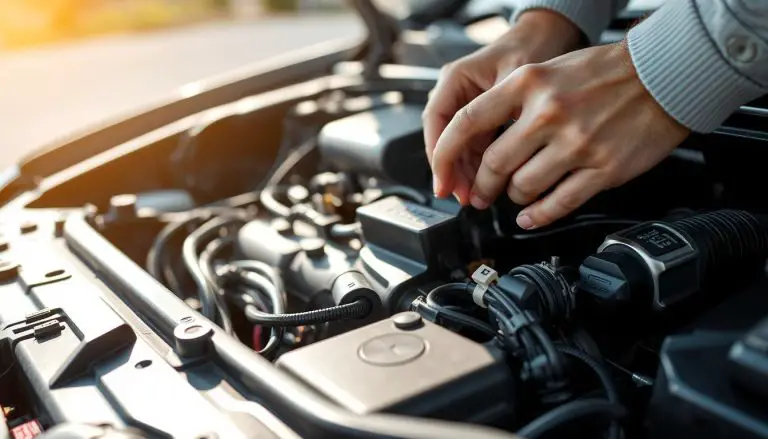Installing an electric fuel pump correctly is crucial for optimal engine performance and safety. The location of the pump affects the overall efficiency and reliability of the fuel system.
A well-installed electric fuel pump ensures that the engine receives the correct amount of fuel under the right pressure. This is vital for maintaining optimal engine performance and preventing potential issues.
The ideal installation spot is critical, as it directly impacts the pump’s ability to supply fuel consistently.
Key Takeaways
- Correct installation is crucial for optimal engine performance.
- The location affects the fuel system’s efficiency and reliability.
- A well-installed pump ensures the right fuel pressure.
- Optimal engine performance depends on the correct fuel supply.
- Proper installation prevents potential fuel system issues.
Understanding Electric Fuel Pumps and Their Function
Electric fuel pumps are the heartbeat of a vehicle’s fuel system, ensuring a consistent supply of fuel to the engine. As such, their proper functioning and installation are critical for optimal vehicle performance.
How Electric Fuel Pumps Work
Electric fuel pumps operate by using electrical energy from the vehicle’s battery to power a motor that pressurizes the fuel system. This pressurization is essential for delivering fuel to the engine, especially under various driving conditions. The pump’s ability to maintain consistent pressure is vital for engine performance and efficiency. As noted by industry experts, “A well-functioning fuel pump is the cornerstone of a reliable fuel system.”
Types of Electric Fuel Pumps
There are several types of electric fuel pumps, including in-tank, external, and high-pressure pumps. In-tank pumps are the most common, offering the advantage of being cooler and quieter. External pumps, on the other hand, are often used in high-performance applications or as replacements. The choice of pump type depends on the vehicle’s specifications and performance requirements.
Why Location Matters for Performance
The location of an electric fuel pump significantly affects its performance and longevity. Mounting the pump in a cooler, more stable environment can enhance its durability and efficiency. Therefore, understanding the optimal mounting location is crucial for maximizing the pump’s performance and ensuring the overall reliability of the fuel system.
The Best Place to Mount Electric Fuel Pump for Optimal Performance
When it comes to electric fuel pump installation, the mounting location is a critical factor to consider. The right placement can significantly enhance your vehicle’s performance, reliability, and safety.
In-Tank Installation: The Manufacturer’s Choice
In-tank installation is often considered the preferred method by manufacturers due to its numerous benefits. It reduces the risk of fuel starvation, minimizes noise, and keeps the pump cooler by surrounding it with fuel. This method is particularly effective in maintaining consistent fuel pressure.
Near-Tank Mounting: The Next Best Option
For those who cannot or prefer not to install the pump inside the tank, near-tank mounting is a viable alternative. This involves securing the pump close to the fuel tank, which can simplify the installation process and still offer relatively good performance.
Frame Rail Mounting: Accessibility vs. Protection
Mounting the electric fuel pump on the frame rail is another common practice. It offers easy access for maintenance and inspection. However, it may expose the pump to more road debris and varying environmental conditions.
Engine Bay Installation: Last Resort Considerations
Installing the electric fuel pump in the engine bay is generally considered a last resort due to the high temperatures and potential for damage from other engine components. However, with proper shielding and planning, it can still be a viable option.
Each mounting location has its pros and cons, and the best choice depends on the specific requirements of your vehicle, including performance needs, available space, and safety considerations.
Safety Considerations for Fuel Pump Placement
Safety considerations play a crucial role in the installation of electric fuel pumps, affecting both the vehicle’s efficiency and the safety of its occupants. A well-planned installation can prevent potential hazards and ensure the vehicle operates reliably.
Heat Sources and Safe Distances
One of the primary safety concerns is the proximity of the fuel pump to heat sources. Excessive heat can lead to fuel vaporization, reduced pump lifespan, and increased risk of fire. It’s essential to maintain a safe distance between the fuel pump and components like the engine, exhaust manifold, or turbocharger.
The recommended safe distance varies among manufacturers, but a general guideline is to keep the fuel pump at least 6 to 8 inches away from any significant heat source. Using heat shields or insulation can also help mitigate the risk.
Protecting Against Road Debris and Elements
Another critical safety consideration is protecting the fuel pump from road debris and environmental elements. Mounting the pump in a secure, sheltered location can prevent damage from rocks, water, or other contaminants that could compromise the pump’s operation or lead to fuel leaks.
Electrical Safety and Wiring Best Practices
Electrical safety is also paramount when installing an electric fuel pump. Proper wiring practices include using the correct gauge wire, securing connections, and ensuring that the circuit is protected by a fuse or circuit breaker. This helps prevent electrical fires or shorts that could disable the pump or cause other safety issues.
Fuel Line Routing for Maximum Safety
The routing of fuel lines is a final key safety consideration. Fuel lines should be routed away from heat sources, sharp edges, and moving parts to minimize the risk of damage or leakage. Using high-quality, fuel-resistant materials for the lines and fittings can further enhance safety.
| Safety Consideration | Best Practice |
|---|---|
| Heat Sources | Maintain 6-8 inches distance, use heat shields |
| Road Debris | Mount in a secure, sheltered location |
| Electrical Safety | Proper wiring, secure connections, fuse/circuit breaker |
| Fuel Line Routing | Avoid heat sources, sharp edges, moving parts |
Step-by-Step Installation Guide
To mount an electric fuel pump correctly, follow this detailed installation guide. Installing an electric fuel pump is a critical task that requires precision and attention to detail to ensure the longevity and performance of your vehicle.
Required Tools and Materials
Before starting the installation, gather all the necessary tools and materials. This includes the electric fuel pump, fuel lines, electrical connectors, mounting hardware, and any additional components specific to your vehicle’s make and model. Having everything ready will streamline the process and reduce the risk of complications.
Preparing Your Vehicle
Preparation is key to a successful installation. Begin by ensuring your vehicle is on a level surface and apply the parking brake. Disconnect the battery to prevent any accidental starts or electrical surges. It’s also advisable to consult your vehicle’s repair manual for specific instructions and precautions.
Mounting the Pump Securely
Mounting the electric fuel pump securely is crucial for its operation and longevity. Choose a location that is protected from heat sources and road debris, as discussed in previous sections. Use the appropriate mounting hardware to secure the pump firmly in place. Ensure that the pump is level and that the mounting points are not subject to excessive vibration.

Connecting Fuel Lines and Electrical Components
Connecting the fuel lines and electrical components requires care to avoid leaks and electrical issues. Use fuel lines that are compatible with your vehicle’s fuel system, and secure them with the appropriate fittings and clamps. For electrical connections, use high-quality connectors and wiring, and ensure that all connections are secure and protected from the elements.
Testing Your Installation
Once the installation is complete, it’s essential to test the system to ensure it’s functioning correctly. Reconnect the battery and turn on the ignition. Check for any leaks in the fuel lines and verify that the pump is operating as expected. Monitor the vehicle’s performance and address any issues that arise promptly.
By following this step-by-step guide, you can ensure a successful installation of your electric fuel pump, enhancing your vehicle’s performance and reliability.
Conclusion
Proper installation of an electric fuel pump is crucial for achieving optimal fuel pump performance. As discussed, the location of the pump plays a significant role in determining its efficiency and longevity. By following best practices for electric fuel pump installation, you can ensure a reliable and high-performing fuel system.
Key considerations include mounting the pump in a location that minimizes exposure to heat sources, road debris, and electrical interference. In-tank, near-tank, and frame rail mounting are viable options, each with its advantages and disadvantages. By understanding these factors and applying the step-by-step installation guide provided earlier, you can achieve a safe and efficient installation.
Ultimately, optimal fuel pump performance is directly tied to the quality of the installation. By adhering to best practices and considering the unique requirements of your vehicle, you can enjoy improved fuel efficiency, enhanced engine performance, and reduced maintenance costs.
FAQ
What is the ideal location for installing an electric fuel pump?
The ideal location for installing an electric fuel pump is typically inside the fuel tank, as it is the manufacturer’s preferred choice, providing optimal performance and safety.
Can I install an electric fuel pump outside the fuel tank?
Yes, you can install an electric fuel pump outside the fuel tank, with near-tank mounting, frame rail mounting, and engine bay installation being alternative options, each with their pros and cons.
What are the safety considerations when installing an electric fuel pump?
Safety considerations include maintaining safe distances from heat sources, protecting the pump from road debris, ensuring electrical safety, and properly routing fuel lines to prevent accidents and ensure optimal performance.
How do I ensure electrical safety when installing an electric fuel pump?
To ensure electrical safety, follow best practices for wiring, such as using the correct gauge wire, securing connections, and protecting wiring from damage and heat sources.
What are the benefits of in-tank installation for electric fuel pumps?
In-tank installation provides several benefits, including improved performance, reduced noise, and increased safety, as the pump is submerged in fuel, which helps to cool the pump and reduce the risk of fuel vaporization.
What tools and materials are required for installing an electric fuel pump?
The required tools and materials include a fuel pump, wiring and electrical connectors, fuel lines, mounting hardware, and other specific components depending on the chosen installation location and vehicle configuration.
How do I test my electric fuel pump installation?
To test your electric fuel pump installation, check for leaks, verify proper fuel pressure, and ensure the pump is functioning correctly, using tools such as a fuel pressure gauge and a multimeter to validate the installation.


